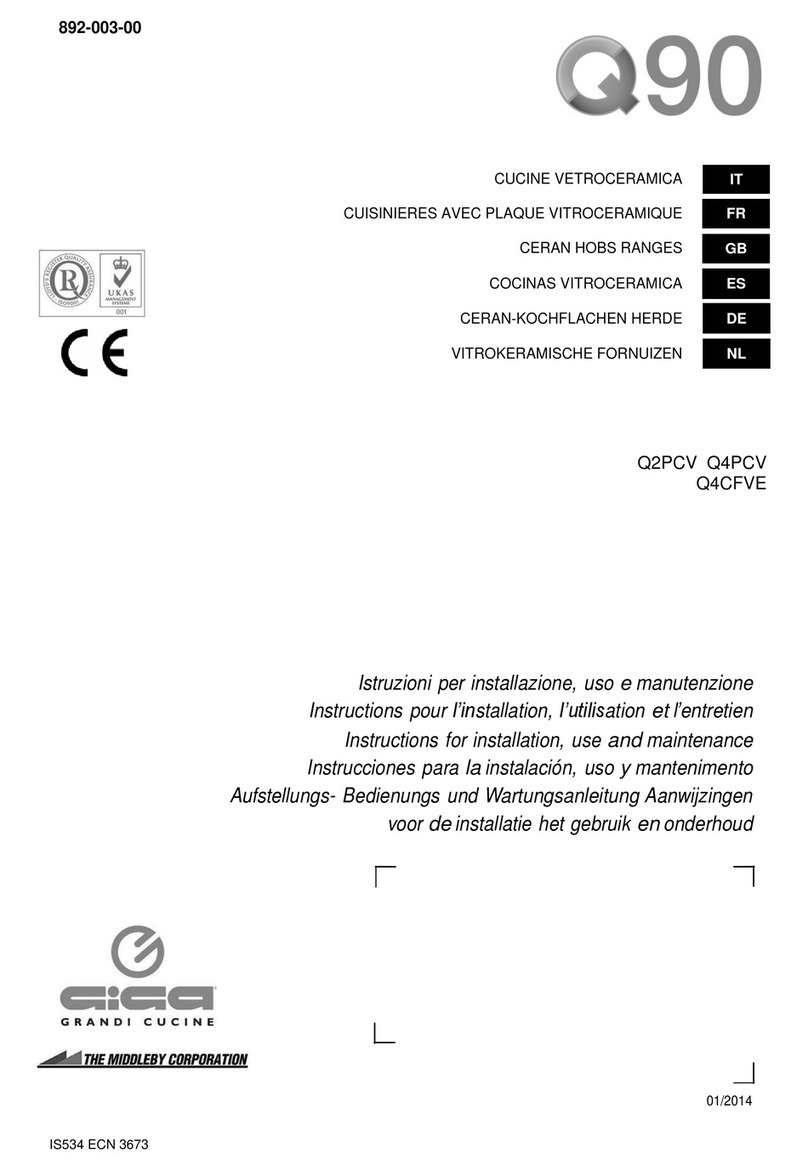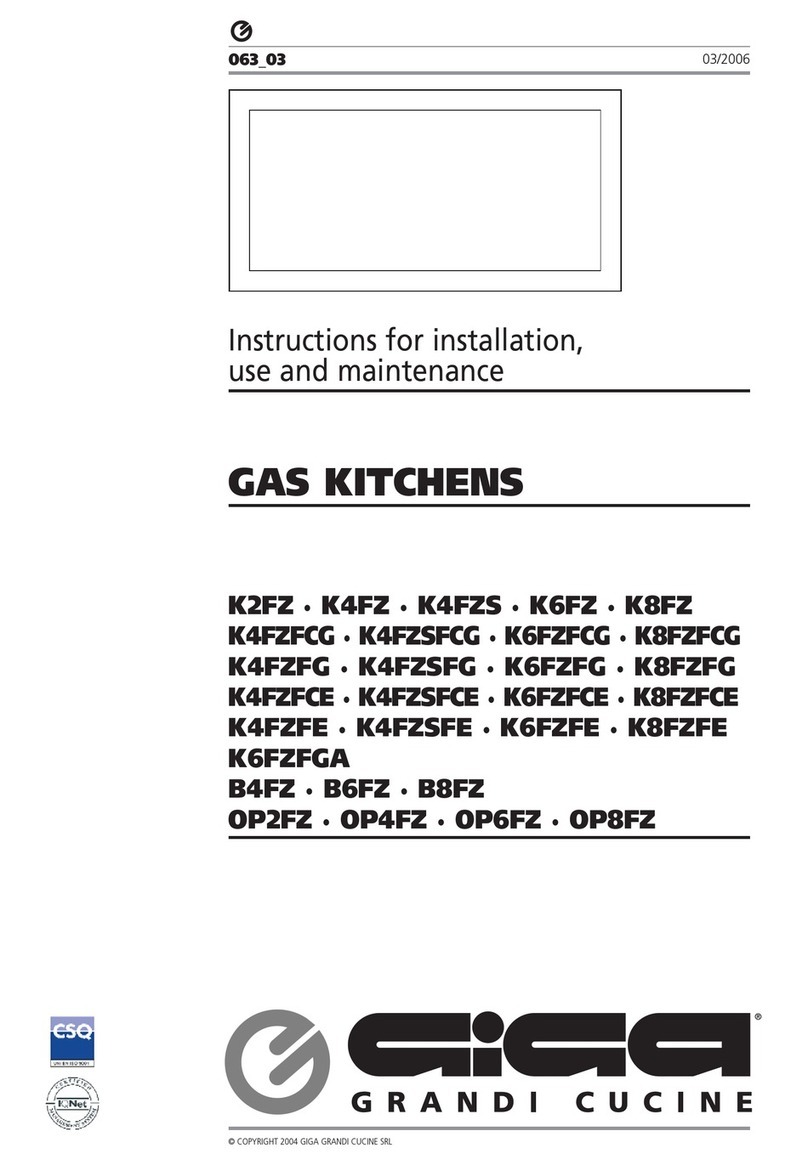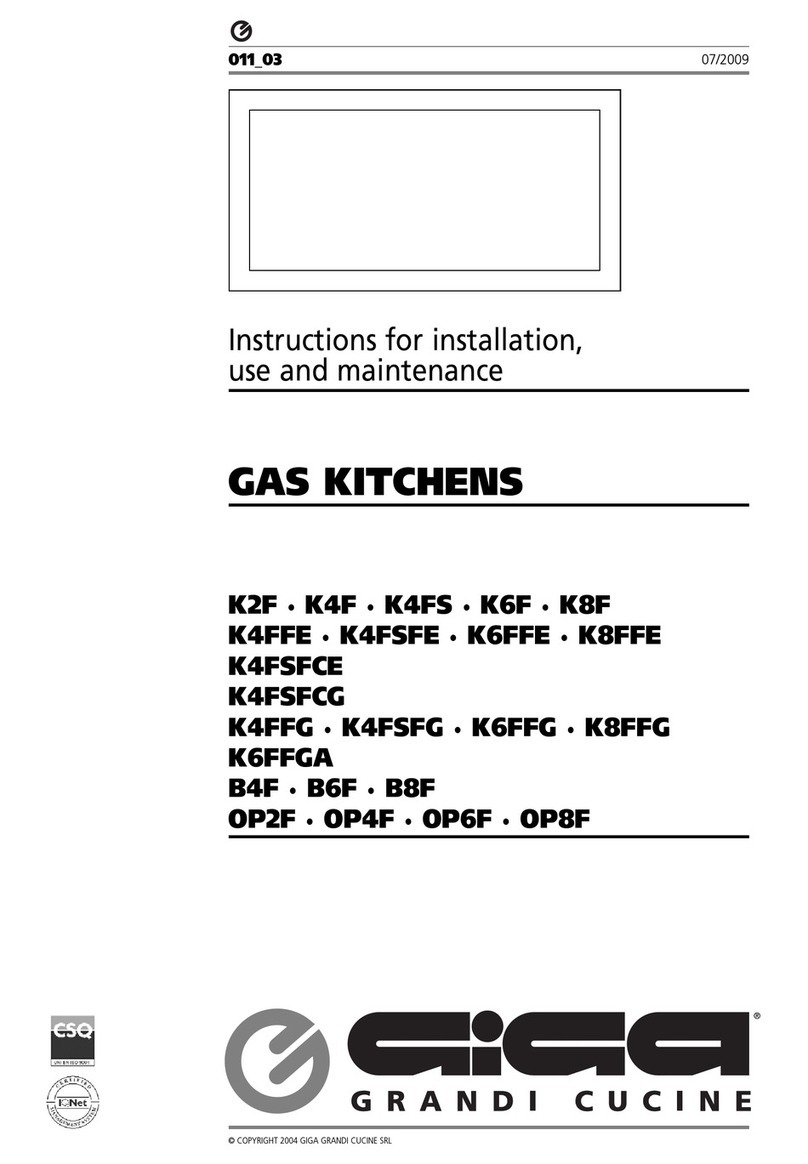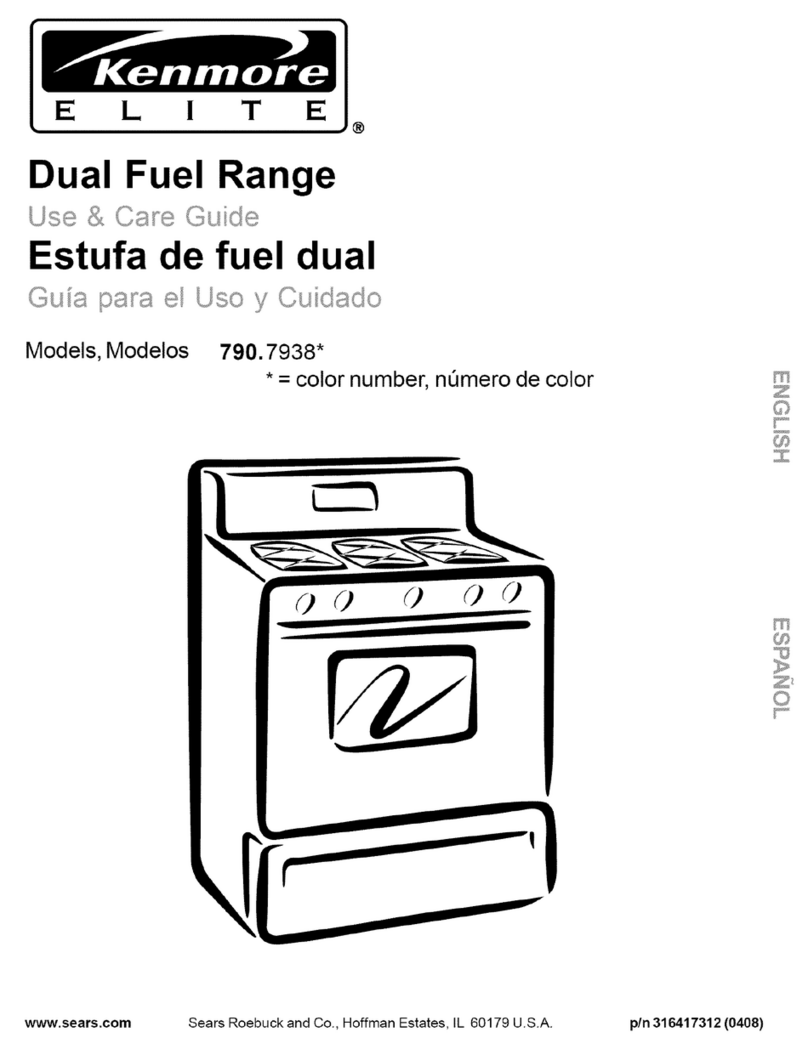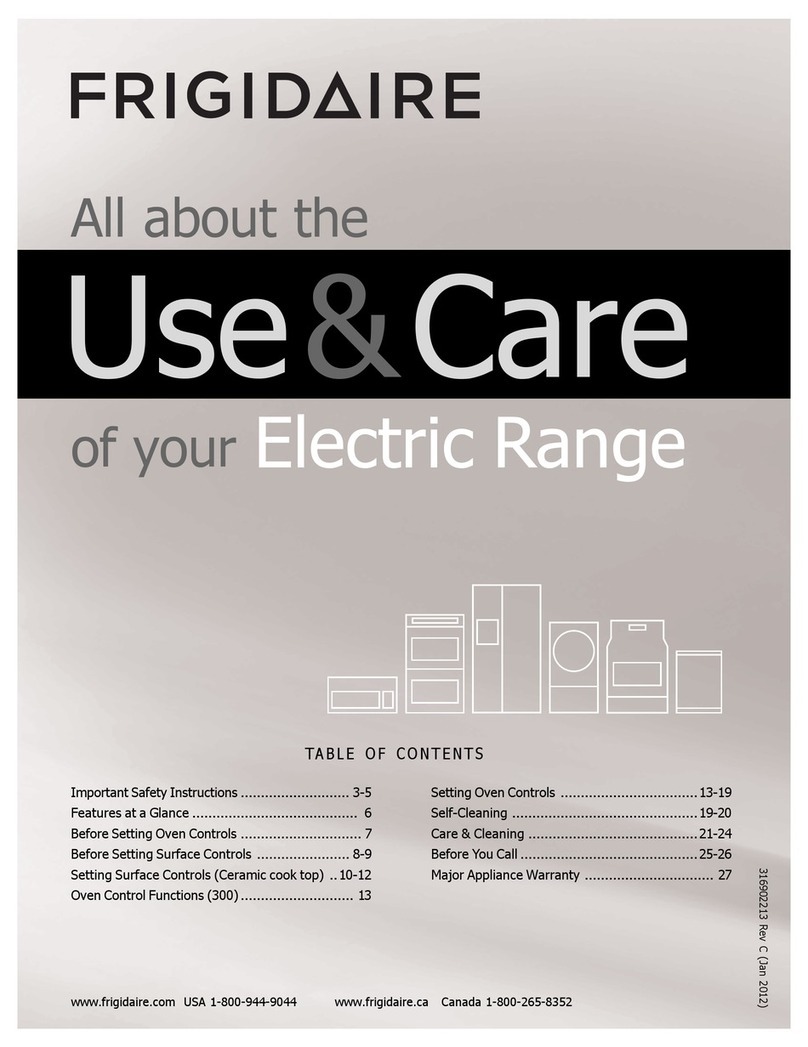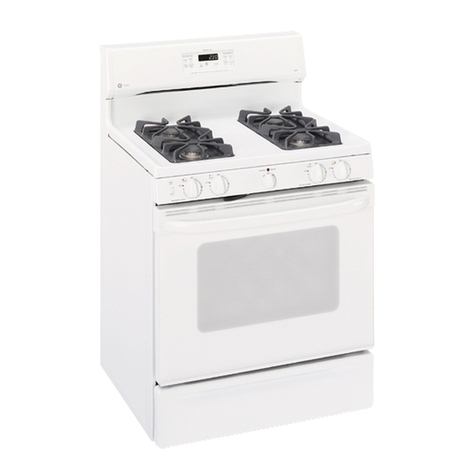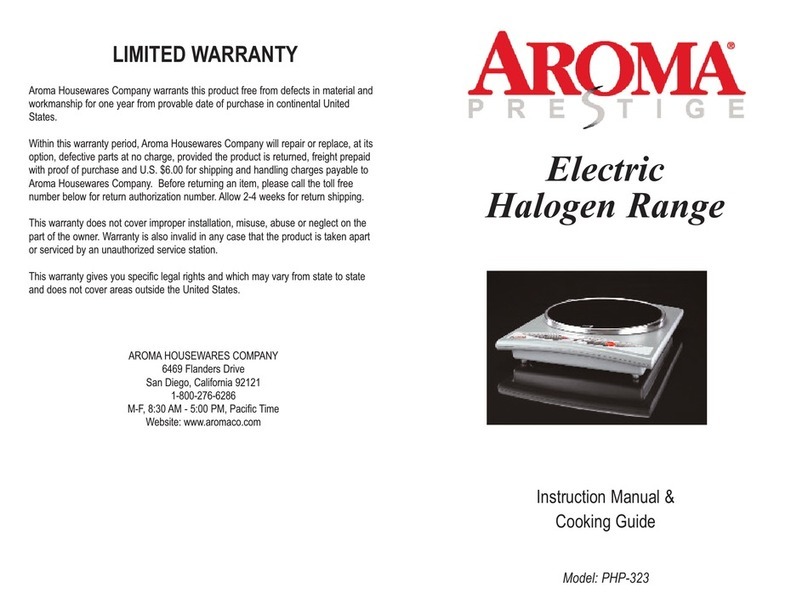GIGA I6FZP Parts list manual

502_03
Instructions for installation,
use and maintenance
09/2015
© COPYRIGHT 2004 GIGA GRANDI CUCINE SRL
GAS KITCHENS
I2FZP
I4FZP
I6FZP

CHARACTERISTICS
502_03 - GAS KITCHENS
2· 16
Supplied by:
Date:
Customer Service:
FAX
e-mail

INDEX
502_03 - GAS KITCHENS
3· 16
1 Diagram 4
2 Features of the appliances 5
3 Technical data 5
4 Installation instructions 6
4.1 Safety rules 6
4.2 Structure, framework and safety devices of the appliances 6
4.2.1 Cooking zone 6
4.3 Assembly 6
4.3.1 Installation premises 6
4.3.2 Statutory regulations and technical requirements 6
4.3.3 Installation 6
4.3.4 Gas connection 6
4.3.5 Smoke extraction 6
4.3.6 Equipotential 6
4.4 Preparing for installation 7
5 Operation preparation 7
5.1 Preparation and Start-up 7
5.1.1 Start-up 7
5.1.2 Check of power 7
5.1.3 Checking the input pressure 11
5.1.4 Power check with volumetric method 11
5.1.5 Power check for operation with liquid gas 11
5.1.6 Check of pilot flame 11
5.1.7 Checking the primary air 11
5.1.8 Operation Control 12
5.1.9 Operator training 12
5.1.10 Conversion and adjustment 12
5.1.11 Replacement of burner nozzles 12
5.1.12 Setting reduced capacity power 12
5.1.13 Replacement of pilot nozzle (open flames) 12
5.2 Maintenance 12
5.3 Replacing parts 12
5.3.1 Gas valve (open flames) 12
5.3.2 Thermocouple (open flames) 12
6 Instructions for use 13
6.1 Safety, cleaning and repair rules 13
6.2 Start-up 13
6.2.1 Lighting and disconnecting open flame burner 13
Shutdown 13
6.3 Turning the appliance off in case of breakdown 13
6.3.1 What to do in case of failure or prolonged period of
disuse 13
6.4 Appliance care and frequency of maintenance 13
6.5 Recommendations for handling stainless steel industrial
kitchens 14
6.5.1 Useful information on stainless steel 14
6.5.2 Warnings and advice for maintenance of stainless steel
appliances 14
6.5.3 WEEE Directive 15

1 - DIAGRAM
502_03 - GAS KITCHENS
4· 16
I6FZPI6FZPI4FZPI4FZPI2FZPI2FZP
I6FZPI6FZPI4FZPI4FZPI2FZPI2FZP
TT
GG
11.511.5
400400
1515
257257
100100
14.514.5
9090
48484848 257257
377377
316316
356356
610610
1515
100100
160160
14.514.5
9090
407407
3333 170170
219.5219.5
204.5204.5 1515
100100
14.514.5
9090 1515
755755
716716
777777
11.511.5
800800
4848
135135
6767
6767
11161116
755755
6767
1515
9090
14.514.5
100100
12001200
11771177
11.511.5
257257
4848 257257
4848
257257
4848 257257
7.8
kW
4.0
kW
4.0
kW
4.0
kW
7.8
kW
4.0
kW
4.0
kW
7.8
kW
4.0
kW
7.8
kW
7.8
kW
4.0
kW
B
BB
B
B
B
B
B
B
B
B
B
B
T
G
Knob
Data plate
Gas connection 1/2"
Fig. 1

2 - CHARACTERISTICS OF THE APPLIANCES
3 - TECHNICAL DATA
502_03 - GAS KITCHENS
5· 16
These appliances are used for professional purposes. Installation,
repair and use must be carried out by expert personnel.
These instructions for installation are for our gas kitchens set up for
the category in the table on page 5. The data plate is located on the
front part of the appliance (on the control panel).
Primary air distance “A”
Methane gas G20
Liquid gas G30/G31
TABLE 1
Category
Construction type
Air necessary for combustion
Nominal thermal power
Minimum thermal power
Overall thermal power (gas)
Connection pressure
Methane gas 2H
Liquid gas 3+
Nozzles Ø 1/100 mm
Main burner
G20
G30/G31
(HuB = 9.45 kWh/m
3
) in m
3
/h
(HuB = 12.87 kWh/kg) in kg/h
Nominal thermal power
Minimal thermal capacity
Nominal thermal power
Minimal thermal capacity
G20
G30/31
20 mbar
28/37 mbar
12.2
24.4
32.8
kW
kW
kW
II2H3+
A
m
3
/h
kW
kW
No. of nozzles, pilot burner
G20
G30/G31
7
Open
X
Ø 100
8
4.0
1.2
0.423
0.313
145
Adjustable
100
45
27
19
15
Open
Z
Ø 120
14
7.8
2.9
0.825
0.611
200
Adjustable
135
75
27
19
1,29
2,58
3,47
-
-
-
-
0,95
1,91
2,57
Hour consumption
G20
m
3
/h
G25
m
3
/h
G30/G31
kg/h
I2FZP
I4FZP
I6FZP
Model
Gas connection values
Methane gas 2H
Liquid gas 3+
Model
I2FZP
I4FZP
I6FZP
Description
2 burners with pilot flame
4 burners with pilot flame
6 burners with pilot flame
Dimensions in mm.
(LxPxH)
400 x 610 x 220
800 x 610 x 220
1200 x 610 x 220
N.
51BQ2896
51BQ2896
51BQ2896
0051
TIPO/TYPE
CAT/KAT GAS/GAZ G30 G31 G20 G25
II2H3B/P P mbar 30 30 20 -
II2H3+ P mbar 30 37 20
-
-
II2H3+ P mbar 28 37 20 -
25II2L3B/P P mbar 30 30
II2ELL3B/P P mbar 50 50 20 20
II2E+3+ P mbar 28 37 20 25
II2H3B/P P mbar 50 50 20 -
I2E P mbar - - 20 -
--II2H3B/P P mbar 30 30
II2H3+ P mbar 28 37 20 -
--
--
I3B/P P mbar 30 30
I3+ P mbar 28 37
SE FI DK CZ SK SI
IT CH PT
ES IE GB GR
NL
DE
FR BE
AT CH
LU
EE LV LT
EE LV LT
NO MT CY IS HU
CY
MOD.
MOD.
ART.
N.
N.
Qn kW
m3/h
MADE IN ITALY
Predisposto a gas: - Gas preset: - Prevu pour gaz:
Eingestelt für Gas: - Preparado para gas: -
Geschuckt voor:
V AC kW Hz
THE APPLIANCE MUST BE CONNECTED IN COMPLIANCE WITH THE LAWS IN FORCE
AND INSTALLED IN A WELL-VENTILATED ROOM. READ THE INSTRUCTION MANUALS
BEFORE INSTALLING AND USING THE APPLIANCE.
THE APPLIANCE MUST BE INSTALLED BY QUALIFIED PERSONNEL.
G30/G31 28/37 mbar
G20 20 mbar

4 - INSTALLATION INSTRUCTIONS
502_03 - GAS KITCHENS
6· 16
4.1 Safety ules
• Installation, modifications and maintenance of the appliance
must be carried out by authorised personnel in compliance with
current safety standards. The manufacturer declines all responsi-
bility for failure to comply with these obligations.
• In compliance with international regulations, when connecting
the appliance to the mains power supply, a device with a mini-
mum aperture of 3 mm between contacts must be fitted
upstream of the appliance, allowing omnipolar disconnection of
the appliance from the mains. Also, a high-sensitivity automatic
differential switch must be installed which protects against direct
or indirect contact with live electrical parts and against current
leakage (maximum current leakage permissible by regulations is
1 mA/kW).
• Compare technical datas on grey stickers to those written on this
manual and present power supply.
• Do not bend, crush or damage the cables against sharp corners.
• Lay the cables so as to avoid contact with extremely hot surfaces.
• Connection to the grid must be carried out with at least a cable
type NYM or H07 N-F.
• The cable - which is totally sheathed – must be led inside the
appliance through the cable clamp and cable raceway installed
on the appliance.
• Ventilation system installation can be carried out only by expert
personnel.
• If the appliance is to be installed near walls, dividing walls, kit-
chen equipment or decorative panelling, these should be in non-
inflammable material. If not, all appliances must be coated with
thermal-insulation fireproof material. Make sure that all fire pre-
vention standards and safety precautions are strictly adhered to.
4.2 St uctu e, equipment and safety devices
of the unit
18/10 chrome-nickel steel outer panelling.
4.2.1 Cooking zone
• Burner with stabilized flame.
• Pilot flame.
• Gas cocks with safety and adjustable from maximum to minimum.
• Thermoelectric ignition safety.
• Enamelled cast-iron pan supports.
• The bodies of the burners, the injector-holder cups and the flame
spreaders are made of nickelled cast-iron.
• 18/10 chrome-nickel steel cooking top.
• Knobs in thermosetting material.
4.3 Assembly
4.3.1 Installation premises
The appliance should be installed in a well-ventilated room, and if
possible under a range hood (check current regulations).
The appliance can be installed on its own or with other similar
equipment.
If the appliance is to be installed near inflammable walls, a minimum
distance of 150 mm around the sides and back should be allowed.
If this distance cannot be obtained, take proper heat-protection
action such as fitting tiles or thermal radiation protection material
to the walls.
Before connecting the appliance to the gas supply, check on the
data plate that the appliance is suitable and type-tested for the
type of gas available.
If the type of gas indicated on the data plate of the appliance does
not correspond to the gas which is present, refer to the paragraph
"Conversion and adaptation".
4.3.2 Stat tory reg lations and technical req irements
During installation of the appliance, the following regulations must
be adhered to:
• elevant legal directives;
• Local building and combustion regulations;
• "Technical rules for gas systems" worksheet;
• "Technical rules for liquid gas" worksheet;
• “Gas installations in industrial kitchens” worksheet;
• elative accident prevention standards;
• Local gas utility regulations.
• Local building and fire codes.
4.3.3 Installation
Before installation, gas connection, power check, conversion or
adjustment and start up ask for gas supply company advice.
4.3.4 Gas connection
The 1/2” gas connection of the appliance to the gas pipeline can
either be permanently fixed to the mains or made detachable using
an approved cock.
After completing gas connection, check for leaks using a special
leak-detector spray.
4.3.5 Smoke extraction
These kitchens are type A appliances, thus no smoke extraction sys-
tem is required.
For the ventilation of the room where the appliance is installed,
refer to related legislation.
4.3.6 Eq ipotential
The appliance must be hooked up to a unipotential system. The
required terminal is located near the cord inlet. It is marked by a
tag with a symbol .
The manufacturers cannot be held responsible for any dama-
ge due to inadequate or incorrect installation or non-com-
pliance with the regulations.

5.1 Preparation and Start-up
Before starting up the appliance, remove the protective wrapping.
Then carefully clean the working surface and the external parts with
lukewarm water and detergent, using a damp rag to remove all traces
of anti-rust material applied in the factory, then dry with a clean cloth.
5.1.1 Start-up
Before starting up the appliance, check that its specifications (cate-
gory and type of gas used) match those of the family and group of
the gas available locally.
If not, it is necessary to adapt the appliance to the gas family or
group required (see paragraph “Conversion and adjustment”).
To start up the appliance, see the instructions for regular use.
5.1.2 Check of power
The appliances must be used with the specific nozzles for the nomi-
nal power.
The power may be:
• the nominal power indicated on the data plate of the appliance;
• the reduced capacity power.
These nozzles are shown in table 1 “Technical data”.
Nominal power is also obtained in respect of the supply pressure:
• from 15 to 22.5 mbar for gases of the second family (G20/methane)
• from 25 to 45 mbar for gases of the 3rd family
(G30/butane, G31/propane)
The appliance shall not be operated outside the above-mentioned
pressure ranges.
To adjust power with reduced capacity, use the data in table 1.
If you wish to further check the nominal power, you may do so by
using a gas meter according to the so-called "volumetric method".
A simple inspection is usually enough to check if nozzles are func-
tioning correctly.
4 - INSTALLATION INSTRUCTIONS
5 - SET-UP FOR OPERATION
502_03 - GAS KITCHENS
7· 16
4.4 Preparing for installation
The gas kitchens type INCASSO must be set on a regular worktable,
made of fireproof material and in compliance with the current
hygiene and safety standards.
It is of vital importance to observe the following instructions.
Kitchens units can go near other appliances such as a fryer, as long
as the required distance of 50 mm (min.) is kept.
In order to install the unit properly on the worktable, proceed as fol-
lows:
A: fig. 2) Base: With a drill, make an opening in the worktable as
described in fig. 2.
The worktable and appliance are clamped with six M5 screws; first
drill the relevant holes in the worktable as described in fig. 2. In
order to prevent liquids from leaking in between the lining and the
appliance, it is necessary to waterproof the leaks with sanitary silico-
ne, anti-mould and heat resistant to at least 100°C (i.e. Pactan 6076).
The knob position is fixed; therefore, in the design of the parts
where the appliance will be fit into, the relevant panel will have to
be provided with a special hole (fig. 1).
B: fig. 3) Housing: Make an opening in the worktable in order to fit
in the appliance as described in fig. 3 (the rise can be performed per-
fectly by means of a bent L-shaped metal support). The appliance is
clamped to the worktable with six M5 screws fit through holes pre-
viously drilled (fig. 3). Fit the appliance and fasten it to the workta-
ble with the screws. Fill the intermediate leak (about 3 mm wide)
with heat resistant (at least 100°C) anti-mould silicone (i.e. Pactan
6067) according to the current hygiene standards. The knob position
is fixed, hence the furniture structure where the appliance has to be
housed will have to be provided with matching holes (fig. 1).
C: fig. 4) Base with anti-seepage edge: Make a frame on the stain-
less steel worktable as described in fig. 4. Fit the appliance and
fasten it with the parts supplied with it. The knob position is fixed;
hence the worktable structure will have to be provided with mat-
ching holes (fig. 1).
In order to prevent overheating of the furniture, it is important to
have air circulate inside the space near the machines. If the space
under the machine housing is accessible, a closing panel must be
put in to prevent accidental contact with hot walls and electric
wires. To this end, it is necessary to make holes at the back and pos-
sibly at the front as well, for a total of at least 40 cm² for the
models 400, 80 cm² for the models 800 and 120 cm² for the models
1200.
This panel must be made of fireproof material and applied at a
distance between 50 mm (min.) and 90 mm (max) from the bottom
of the machine, further, to ensure internal air circulation must be
provided with a hole 40 cm² / 80 cm² / 120 cm². Preferably at the
front (fig. 2/3/4).
Panels and/or inflammable parts must be at a distance of at least
300 mm from the hot walls of the machine.

CHARACTERISTICS
502_03 - GAS KITCHENS
8· 16
760760
777777377377
255 MIN255 MIN
514514
585585
700700
40 MIN40 MIN
3838
5555
1515
100100
9090
3333
6060
360360 MIN 50MIN 50
585585
ØØ77
ØØ77
3333
11771177
11601160
257257 257257
3838
ØØ77
3333
257257 257257
3838
3333
257257 257257
3838
Hole for fixing screwHole for fixing screw
Ventialtion openingsVentialtion openings
Appliance back wallAppliance back wall
585585
585585
Fig. 2

CHARACTERISTICS
502_03 - GAS KITCHENS
9· 16
Hole for fixing screwHole for fixing screw
777777
760760
806806
377377
115115
6060
9393
700700
9090
270 MIN270 MIN
4242
1515
616616
257257 585585
27 MIN27 MIN
9393
1515
4242
5555 257257
360360
406406 MIN 50MIN 50
585585
616616
ØØ77
SiliconeSilicone
33
ØØ77
ØØ77
11771177
12061206
11601160
257257 257257
257257 257257
3333
3838
257257 257257
Ventialtion openingsVentialtion openings
Appliance back wallAppliance back wall
585585
616616
585585
616616
3333
3838
3333
3838
Fig. 3

CHARACTERISTICS
502_03 - GAS KITCHENS
10 · 16
394394 outsideoutside
604604 outsideoutside
Raised edgeRaised edge
Ventialtion openingsVentialtion openings
4343
30 MIN30 MIN
100100
9090
10 MAX10 MAX
255 MIN255 MIN
2020
604604 outsideoutside
604604 outsideoutside
604604 outsideoutside
Fig. 4.1Fig. 4.1
794794 outsideoutside
MIN 50MIN 50
Appliance back wallAppliance back wall
11941194 outsideoutside
SupportSupport
Fig. 4

5 - SET-UP FOR OPERATION
502_03 - GAS KITCHENS
11 · 16
5.1.3 Checking the input pressure (fig. 5)
Input pressure should be measured using a fluid measuring gauge
(e.g. a gooseneck pipe, min. resolution 0.1 mbar).
Remove lock screw (22) from the pressure intake tube and connect the
gauge hose: once measurement is complete, replace the screw (22).
5.1.4 Power check with volumetric method
Using a gas meter and a stopwatch, you can read the volume of gas
output per time unit. The correct volume corresponds to the value
"E" expressed in litres/hour (l/h) or litre/minute (l/min).
The following formula is used to calculate the value of “E”:
It is important measure the power when the appliance is in standby
status.
The calorific power value can be requested from the local gas company.
The nominal power and the minimum power with respect to the
nominal pressure are obtained by consulting the table for the
adjustment of the gas passage (table 1).
WARNING
There is no pre-adjustment device for the nominal
power.
5.1.5 Power check for operation with liquid gas
Check if the type of nozzles used meet manufacturer requirements.
Check that the pressure reducer installed in the system has an outlet
pressure which is compliant with paragraph 5.1.2 "Check of power"
(can be checked on the data plate of the appliance or by measuring
the pressure).
5.1.6 Check of pilot flame
For proper regulation, the pilot flame must surround the thermo-
couple and it must have a perfect appearance; otherwise, check
injector (table 1) and gas pressure.
5.1.7 Checking the primary air
The open flames are equipped with primary air adjustment (table
1).
Air volume flow is correct when there is sufficient protection
against the flame rising when the burner is cold or in case of flash-
back when the burner is hot.
6
8
7
9
22
5
4
0
21
3
11
13
12
14
17
1
2
10
A
Fig. 5
E = Power
Operating calorific value

5 - SET-UP FOR OPERATION
502_03 - GAS KITCHENS
12 · 16
5.1.8 Operation Control
• Start the appliance in accordance with the instructions;
• Check that the appliance does not have any leaks by using a leak-
detecting spray.
• Check ignition and that flame on the main burner lights properly
and is correctly formed, even on low.
• Check that the pilot flames work properly.
• A servicing and maintenance contract is recommended.
5.1.9 Operator training
• Explain and show the user how the machine works according to
the instructions, and hand him this manual.
• Remind the user that any structural alterations or any building
modification or renovation may affect the combustion air supply,
thus requiring a second operation check.
5.1.10 Conversion and adjustment
To change over form one kind of gas to another, for example from
methane to liquid gas, or to another type of gas, the use of suitable
nozzles for the main burner is required, in accordance with the table
"TECHNICAL DATA".
The nozzles of the main burners and pilot for different types of gas,
marked with the relative diameter in hundredths of mm, are in an
envelope which is provided with the appliance. After transforma-
tion or adaptation, carry out operating checks as described in para-
graph 5.1.8, "Operation control."
5.1.11 Replacing burner nozzles (fig. 5)
To replace the nozzle (1): remove the grill, the burner cover, the
burner body and the tray of the top.
Then unscrew the screws (2) which fasten the primary air bushing
and replace the nozzle (1). See the table "TECHNICAL DATA".
Once the suitable nozzle has been installed, adjust the distance of
the primary air and fasten the bushing with the appropriate screw.
See the table "TECHNICAL DATA".
5.1.12 Setting reduced capacity power (fig. 5)
The minimum setting screw (5) should be adjusted as follows:
• for operation with LPG it should be screwed all the way down;
• for operation with methane, use the gas flow table to check the
value in l/min with respect to the operating alorific value (meas-
urement in accordance with the volumetric method). Start the
appliance in accordance with the instructions. Turn the knob to
the minimum position and use screw (5) to adjust the flow (clock-
wise = flow reduction; conter-clockwise = flow increase).
5.1.13 Replacement of pilot nozzle, open flames (fig. 5)
Remove the grill, the flame separator and the pilot body. Loosen the
screw that holds the pilot to the burner and lift it to a more conven-
ient position. Loosen the nut (11) and extract the bicone (13) and
the injector (12). Replace the injector. See the table "TECHNICAL
DATA" and re-assemble, performing the steps in reverse order.
5.2 Maintenance
Attention! Before doing any repair or maintenance
work, unplug the appliance.
The following maintenance program should be carried out at least
once a year:
• Check that all the safety and adjustment devices are working
properly;
• Check that the burners are working properly with regard to:
- ignition
- combustion safety;
Check functioning of the appliance as described in paragraph
"Operation Control";
If it should be necessary to clean the open flame burners, proceed
as follows:
• Clean the grills, covers and bodies of the burners;
• Clean the parts with water and detergent and an appropriate
tool. Rinse and dry.
When reassembling the parts, make sure you place them back in the
right position.
5.3 Replacing parts
All parts must be replaced by authorized technicians
only!
To replace the following parts first remove all the control knobs and
control panel (after loosening the fixing screws), then extract the
ignition wire.
5.3.1 Open flame gas valve (fig. 5 - pos. 4)
Loosen the fitting of the pipes (6) and (9) of the gas and of the
thermocouple (8), loosen the fitting (7) for the fastening of the
valve on the ramp and replace the piece.
5.3.2 Open flame thermocouple (fig. 5 - pos. 14)
Loosen the nut (8) for fastening the thermocouple on the valve and
on the burner (17) and replace the piece (14).

6 - INSTRUCTIONS FOR USE
502_03 - GAS KITCHENS
13 · 16
6.1 Safety, cleaning and repair rules
• This appliance is used for the preparation of meals at industri-
al level. Usage and cleaning can be carried only by expert per-
sonnel. Maintenance and repair can be carried out only by
skilled technical personnel.
• These indications must be communicated to all those con-
cerned during internal training.
• Attention! This appliance must be constantly watched over
when being used!
• Grease and overheated oil can catch fire. Use this appliance
only under constant control. Never use water to put out
grease or oil! Cover with a lid, turn off the hot plate and
remove pot from the burner.
• Do not leave the burners running.
• Do not overload the kitchen. For proper use, pots should
not be bigger than the flames.
• Parts of the appliance and attachments exposed to food
must be cleaned with detergents and rinsed thoroughly with
potable water.
• Do not clean the appliance using water jets or steam,
whether direct or pressurized!
• If the room is being cleaned with water/steam jets or high-pres-
sure equipment, it is necessary to switch off the appliance first!
• Before starting to clean the appliance, disconnect from the
mains.
• Do not use inflammable liquid to clean the appliance.
• Repairs may be carried out only by skilled personnel.
• During repairs, the appliance must undergo voltage
omnipolar insulation (local switch, i.e. safety load cut-off
switch).
• Noise emission values of the appliance in operation are below
70dB (A). This value is compulsory according to certain national
safety standards.
WARNING
Attention! The manufacturer declines all responsibility concern-
ing mistakes included in these instructions due to translating or
printing errors: the manufacturer also reserves the right to
change the product as he see fits, though without changing its
essential features. The manufacturer declines all responsibility for
any non-compliance with the provisions contained in this manu-
al.
6.2 Start-up
6.2.1 Lighting and shutting off open flame burner (Fig. 1)
Turn the knob of the desired burner (21) to the spark position. Press all
the way down and use a match or other suitable instrument to light
the pilot burner. Hold the knob down for 15-20 seconds. If, when the
knob is released, the pilot light goes out, repeat the operation.
Then place the knob in the maximum or minimum position so that
the main burner ignites.
To shut off the burner, turn the knob to the right to the spark posi-
tion, and the main burner will go out.
To shut off the pilot light, place the knob in position (0).
Shutdown
To shut off the main burner, turn the knob to the spark position. Only
the pilot flame will remain lit. For complete shutdown, turn the knob
to position (0); in this position the pilot burner also goes out.
6.3 Turning the appliance off in case of
breakdown
In case of breakdown, shut down the appliance as instructed in the
paragraph "What to do in case of failure or prolonged period of
disuse". In case of breakdown, close the connecting cock of the
unit. Disconnect the appliance from the power mains.
6.3.1 What to do in case of failure or prolonged peri-
od of disuse
When the appliance is not to be used for a long time, clean thor-
oughly, close the gas cock and switch off any electric power.
In case of malfunctioning or failure, close the gas cock. In case of
malfunction, call the service centre.
6.4 Appliance care and frequency of maintenan-
ce
Attention! When cleaning, carefully avoid washing the
appliance with direct water jets or high-pressure
water!
Cleaning must be performed when the appliance is cold.
Thorough daily cleaning of the appliance, after disconnecting it, will
keep it in perfect working order and make it last longer. All steel
parts should be cleaned with water and a detergent, using a damp
cloth; do not use abrasive substances or corroding detergents.
Do not use steel wool, which could cause rust to form.
For the same reason, avoid touching the appliance with anything
made of iron. Do not clean with sandpaper and lubricating gel paper.
If absolutely necessary, you may use pumice powder.
If the appliance is extremely dirty, use a synthetic sponge (i.e.
Scotchbrite sponge).
After cleaning the appliance, rinse with clean water and wipe with
a clean cloth.
If the main burner needs cleaning, proceed as follows:
• Remove the pan support, cover, rings and burner crown;
• Clean burner parts with water, soap and a suitable tool, then
rinse and wipe;
• When reassembling the parts, make sure you place them back in
the right position.
All maintenance and repair work must be carried out by authorized
technicians only.
Never clean the appliance with water jets or high-pres-
sure water!
The appliance must be checked at least once a year. For this reason,
a service agreement contract is recommended.

6 - INSTRUCTIONS FOR USE
502_03 - GAS KITCHENS
14 · 16
6.5 Recommendations for the treatment of
stainless steel industrial kitchens
6.5.1 Useful information on stainless steel
Industrial kitchens are generally made of stainless steel having the
following material codes:
• 1.4016 or 1.4511 = magnetizable chromed steels
• 1.4301, 1.4401 and 1.4571 = non-magnetizable chromed steels
Chromed steels have favourable thermo-technical characteristics. In
fact, they have less of a tendency to warp due to the effect of heat.
Chrome-nickel steels, instead, have good corrosion resistance features.
Stainless steel corrosion resistance is given by an inactive coat that
builds up on the surface by coming into contact with oxygen.
The oxygen in the air is already enough to build up the inactive coat
that allows automatic removal of anomalies and damage due to
mechanical actions. The inactive coat builds up or re-builds up faster
if the steel comes in contact with running water containing oxygen.
A more powerful effect is given by oxidative acids (nitric acid, oxalic
acid). These acids are used if the steel has undergone strong chemi-
cal stresses, hence generally losing its inactive coat.
The inactive layer can be chemically damaged or jeopardized by
reducing agents (oxygen consumption) if they come in contact with
the steel, concentrated or at high temperatures. These active sub-
stances include for instance:
• saline and sulphurous substances
• chlorides (salts)
• concentrated spices such as mustard, vinegar essences, soup
cubes, kitchen salt solutions, etc.
More damage can be caused by:
• outside rust (i.e. from other components, tools or incipient rust)
• iron particles (i.e. file dust)
• contact with non-ferrous metals (element build up)
• lack of oxygen (i.e. no air inlet, water lacking oxygen).
6.5.2 Warnings and advice for maintenance of stainless
steel appliances
• Stainless steel equipment surfaces must be kept clean and in con-
tact with air at all times. When not running, keep appliance
doors open so as to allow air to run through it.
• Regularly remove calcium , grease, starch, and egg white deposits
where rust may build up if there is lack of air. Do not use bleach-
ing products or products containing chloride. Follow all indica-
tions given by the company concerning special soaps and clean-
ing methods to be used for the appliance. If no specific cleaning
recommendations are available, it is necessary, however, to use
detergents having a low chloride content. After cleaning, remove
all soap residues with plenty of clean water and thoroughly dry
the surfaces.
• Minimize contact of stainless steel with concentrated acids,
spices, salts, etc. Even acid vapours coming from cleaning the tiles
favour stainless steel corrosion.
• Particularly for pots and multiple appliances, it is not recom-
mended to load the cooking chamber only with food having a
high salt content.
It is preferable to cook different food together, i.e. fatty dishes
or vegetables containing acids.
• Avoid damaging the stainless steel surface, in particular with dif-
ferent metals. Residues from other metals help build up the for-
mation of chemical microelements that may cause rust. At any
rate, it is appropriate to avoid contact between iron and steel
since it produces rust. Any contact between stainless steel and
iron (steel wool, pipeline chips, chalybeate waters) can start cor-
rosion phenomena.
As for mechanical cleaning, it is recommended to use only steel
wool or natural, plastic or steel bristle brushes. Steel wool or
brushes with stainless steel can cause rust due to rubbing. Newly
formed rust spots can be removed with slightly abrasive liquid
soaps or fine-grained sand paper. Larger rust spots can be
removed with 2-3% of hot oxalic acid solution. If these cleaning
products do not do the job, a nitric acid (10%) treatment is
required.
Attention! These treatments can be carried out only by
expert personnel according to current regulations.

6 - INSTRUCTIONS FOR USE
502_03 - GAS KITCHENS
15 · 16
NOTES
6.5.3 The 2002/96/EC (WEEE) Directive:
information to users
This informational note is meant only for
owners of equipment marked with the
symbol shown in fig. A on the adhesive
label featuring the technical specifications
applied on the actual product (the label
also giving the serial number).
This symbol indicates that the product is classified, according to the
regulations in force, as an item of electrical and electronic equipment
and conforms to EU Directive 2002/96/EC (WEEE) meaning that, at the
end of its service life, it must be treated separately from domestic
waste, i.e. it must be handed in free of charge to a separate waste
electrical and electronic equipment collection centre or returned to
the reseller when buying a new equivalent item of equipment.
The user is responsible for delivering the unit at the end of its life to
the appropriate collection facilities. Failure to do so shall result in the
user being subject to the penalties prescribed by the legislation in
force on waste.
Suitable separated collection so that the unit no longer used can be
sent off for environmentally compatible recycling, treatment and
disposal helps avoid possible negative effects on the environment and
on health and facilitates the recycling of the product's component
materials.
For more detailed information on available collection systems, contact
the local waste disposal service or the shop you purchased the unit
from.
Producers and importers fulfil their responsibility for environmentally
compatible recycling, treatment and disposal both directly and by joi-
ning a collective scheme.
Fig. A

GIGA GRANDI CUCINE S.r.l. - Via Pisana, 336 - Loc. Olmo - 50018 SCANDICCI (FI) - ITALY -
Tel. +39 055 722 33 (11 linee r.a.) - Fax +39 055 7310 056 - www.gigagrandicucine.it -
WARNING
THE MANUFACTURER CANNOT BE HELD RESPONSIBLE
FOR ANY INACCURACIES IN THIS BOOKLET DUE
TO COPYING OR PRINTING ERRORS.
DUE TO ITS POLICY OF CONTINUAL PRODUCT IMPROVEMENT,
THE MANUFACTURER RESERVES THE RIGHT
TO MAKE ANY CHANGES DEEMED NECESSARY.
THE MANUFACTURER CANNOT BE HELD RESPONSIBLE
IF THE INSTRUCTIONS CONTAINED IN THIS MANUAL
ARE NOT OBSERVED.
This manual suits for next models
2
Table of contents
Other GIGA Range manuals
Popular Range manuals by other brands

Jenn-Air
Jenn-Air JENN-AIR Use and care guide
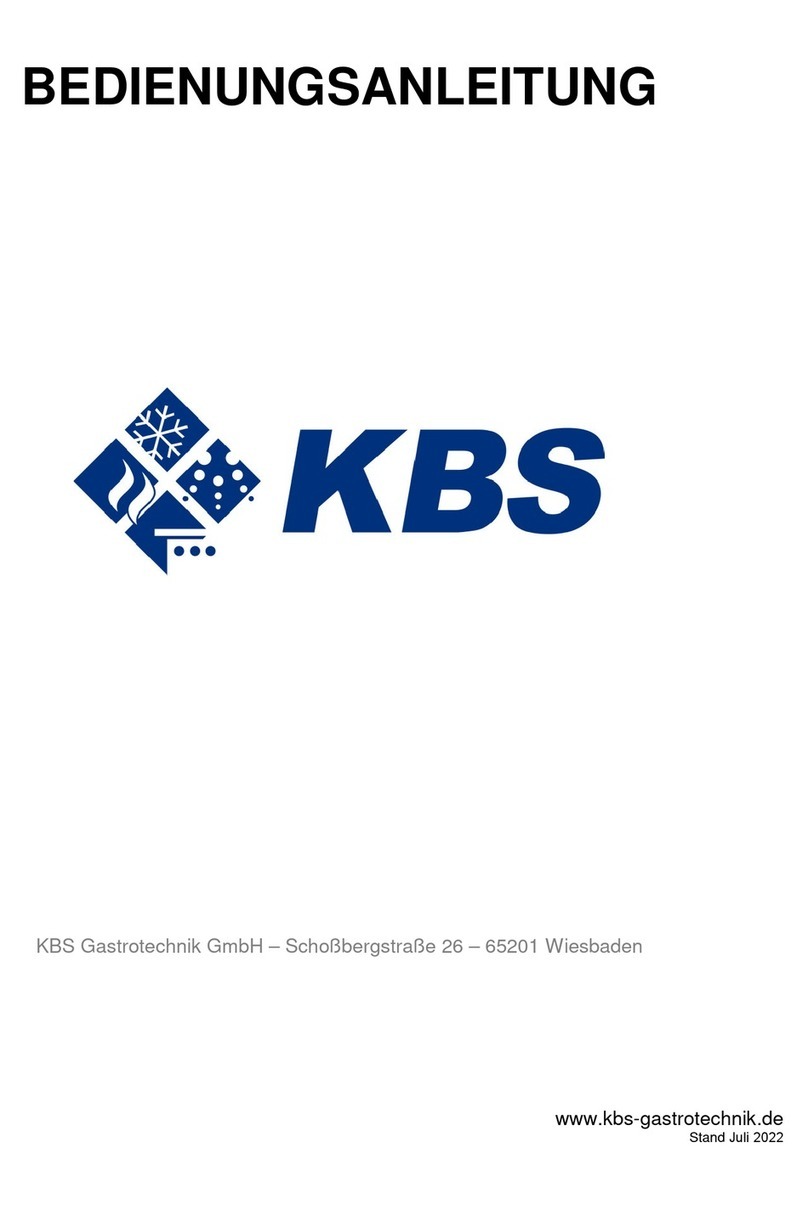
KBS Gastrotechnik
KBS Gastrotechnik NGER 4-60 Installation, operation and maintenance instructions
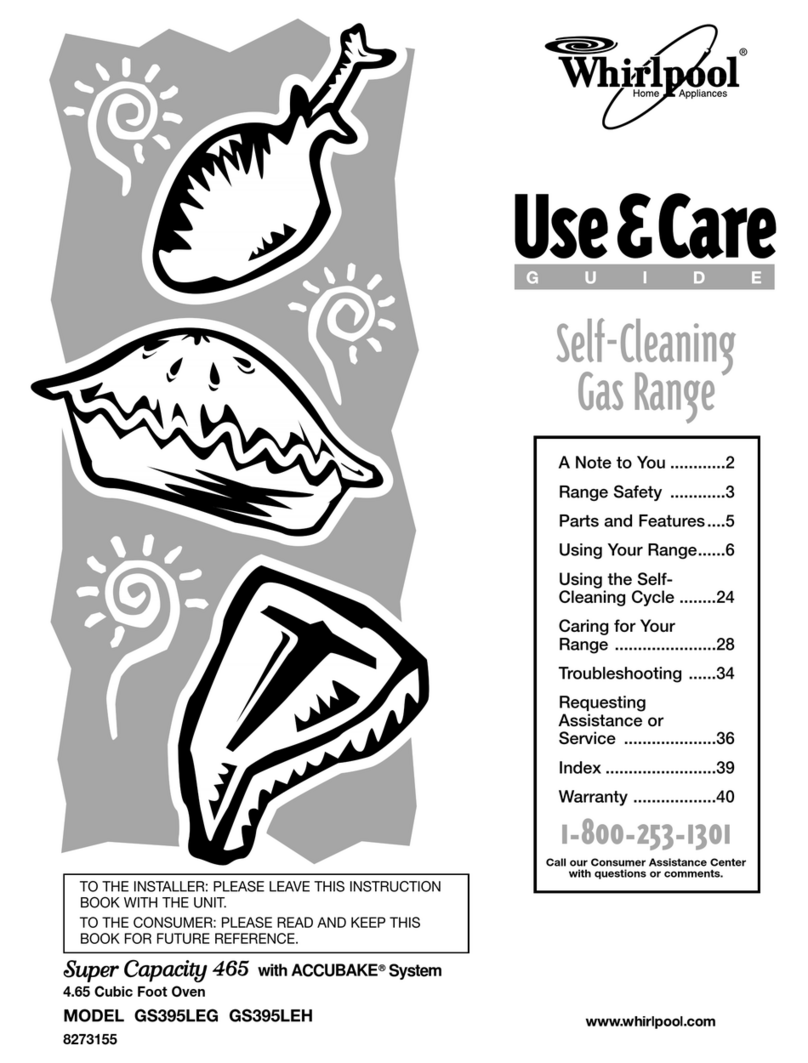
Whirlpool
Whirlpool GS395LEH Use & care guide
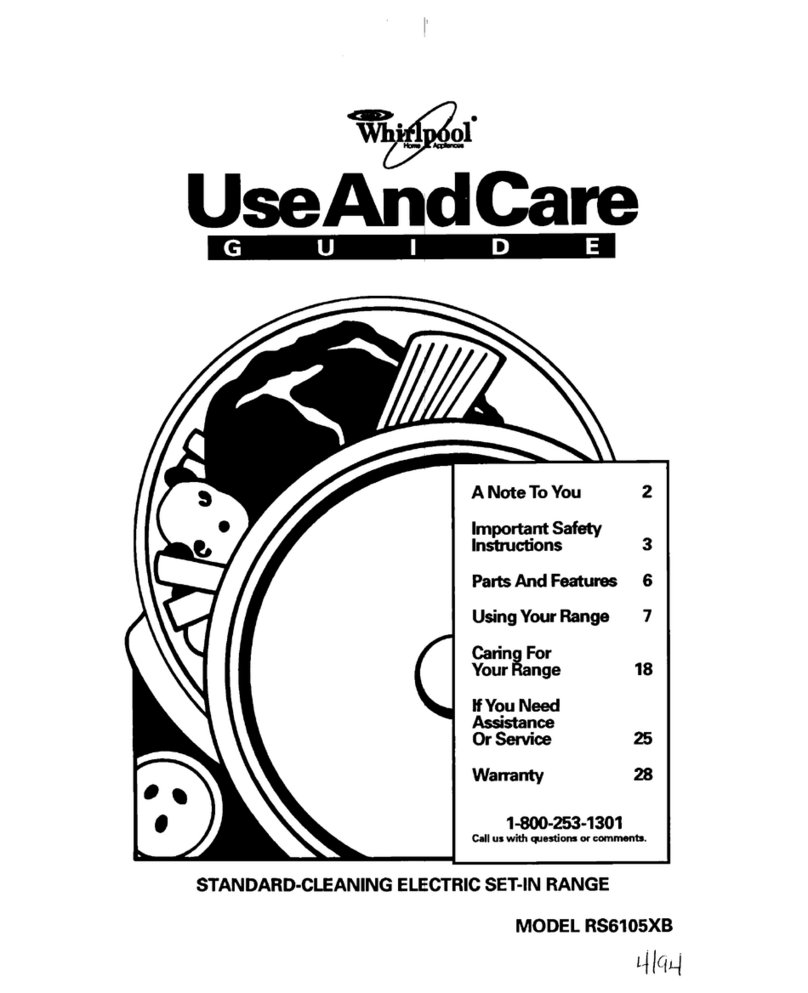
Whirlpool
Whirlpool RS6105XB Use and care guide
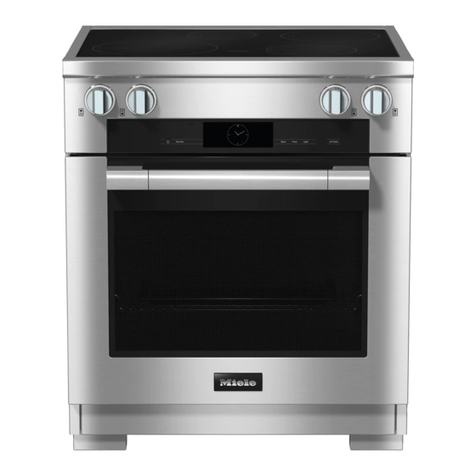
Miele
Miele 30" Induction Range operating instructions
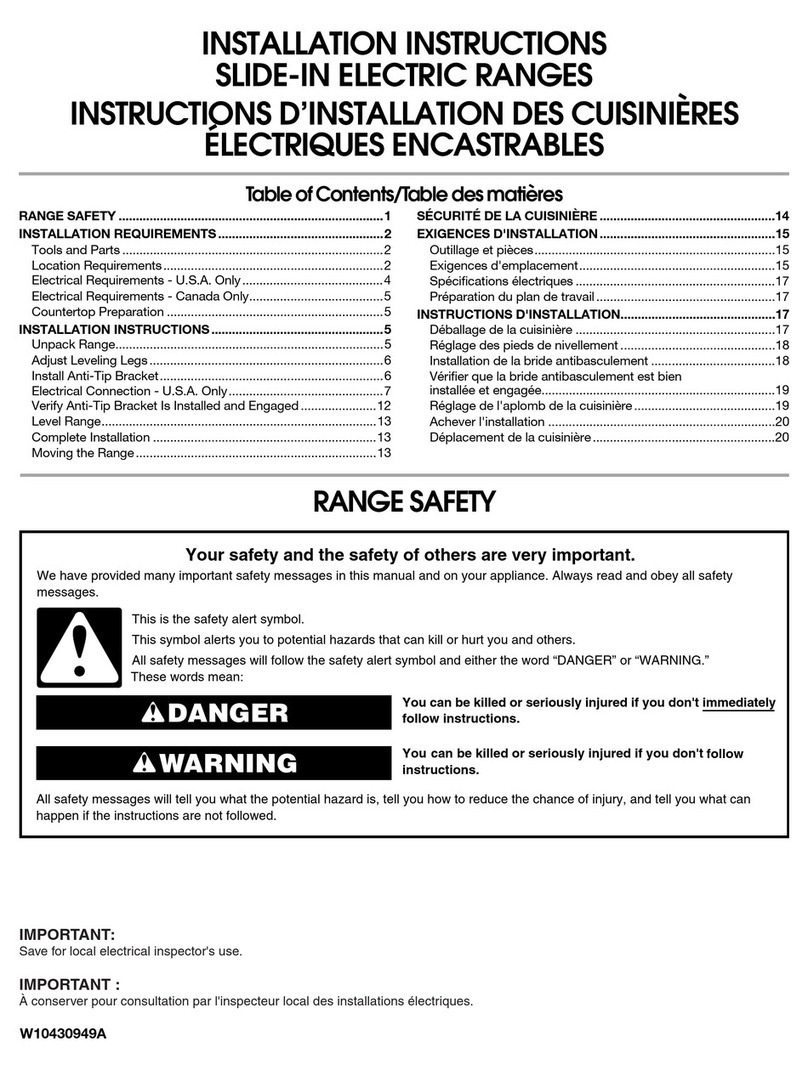
Whirlpool
Whirlpool GY397LXUQ installation instructions
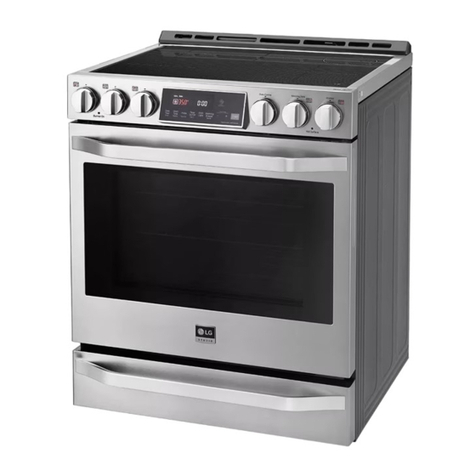
LG
LG LSIS3018 owner's manual
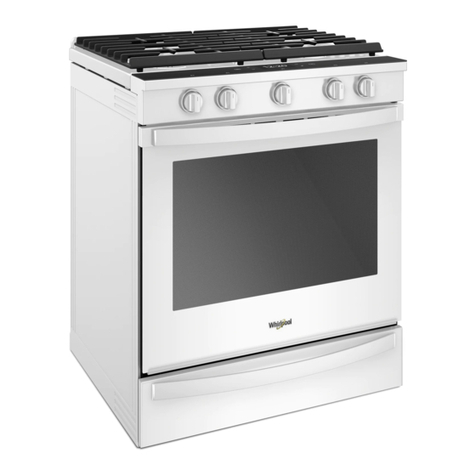
Whirlpool
Whirlpool WEG750H0HW User instructions
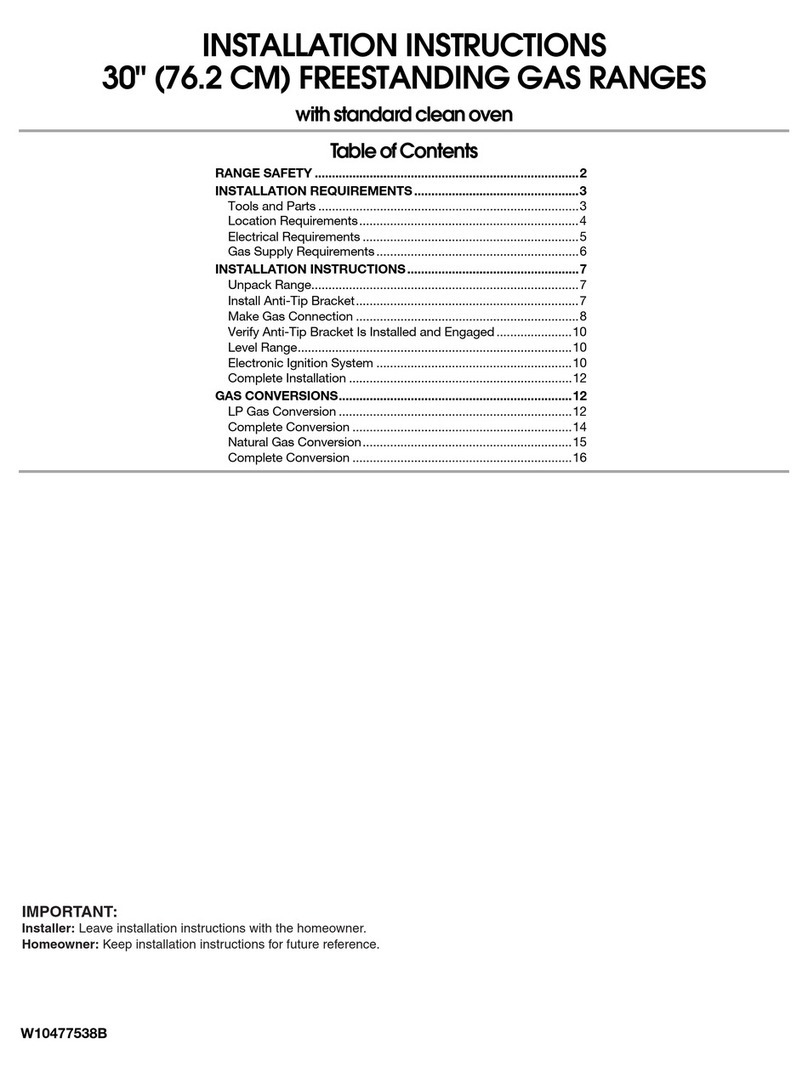
Whirlpool
Whirlpool 30" (76.2 CM) FREESTANDING GAS RANGES installation instructions

Kenmore
Kenmore 79045013100 installation instructions

Whirlpool
Whirlpool RF317PXW Use & care guide

KitchenAid
KitchenAid 9760618 installation instructions
